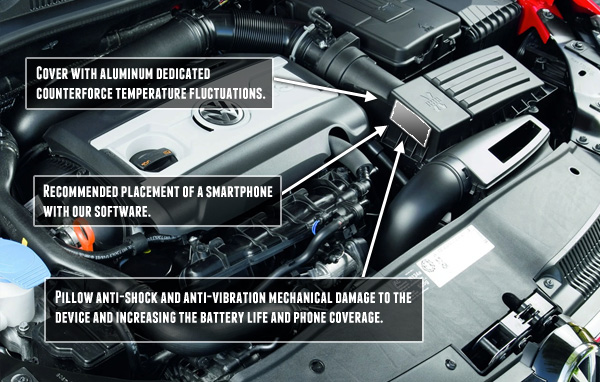
Volkswagen Golf Mk6 GPS Tracking
Track your Golf Mk6 for free and visualize it on map
Produced to: 2013
How to track your favourite Volkswagen - model Golf Mk6 in realtime for free ?
Producer remarks about this particular model
Volkswagen Golf VI - the sixth generation of the German Volkswagen Golf compact car produced from 2008 to 2012. Auto numbered VI debuted on the market about two years earlier than expected. This was due to the fact that the predecessor - the Golf V is not met the expectations of Volkswagen AG and customers. Thus, when designing a new model also erected on the reduction of production costs . In the initial phase motor produced 10 versions. The new generation of the car from Wolfsburg took over from his predecessor, the floor plate and the roof structure. The rest of the body components have been redesigned or subjected to modernization. Previous version combo ( Golf V Variant) soon went through a successor - the production (2007-2009 ) was delayed by less than four years in relation to the hatchback. The current combo Golf also created in Puebla and varies even less than its predecessor than the base model ( Golf V Variant was not even round LED rear lamps ) . Similarly, the 4MOTION version is only available as a combo with a 105 -hp TDI engine (now he has a displacement of 1.6 l) , and the elements of the rear axle is not reduced in the boot capacity (505 l) , as is the case in hatchback ( with a shorter rear overhang ) , where 4x4 is only for the 140 PS 2.0 TDI CR unit . In a plebiscite on the European Car of the Year 2009 model took 3 position ( for the Opel Insignia and the seventh generation of the Ford Fiesta ) [1 ] . In 2009, the car won the title of World Car of the Year.Our product description
We are offering you completely free of charge our GPS car tracking solution in real time. The only thing you need to do is to install smartphone with Android inside your vehicle with our awesome application on board
If you want to track your Volkswagen Golf Mk6 in real time you have to do the following :
1. Download Free Car Tracking Application for Golf Mk6 application from Google Play
2. Create free account on spysat.eu (for example johndoe) - here is detailed instruction
3. Define Device endpoint for each vehicle you want to track - give friendly name of your Golf Mk6 and PIN (some random will be provided - you can change it if you want)
4. Run SpySat mobile application on the smartphone and type there your LOGIN from SpySat (ex. johndoe) and PIN (from point 3.)
5. Install your smartphone inside the car
6. Enjoy watching position of your car at spysat.eu site.
7. Provide stable power supply - spysat app consumes some energy.
Best options to install smartphone inside Volkswagen Golf Mk6

Our engineers together with engineers from Volkswagen developed an optimal place we should put a tracking device. The device should be packaged in a special case. It is protected against mechanical shock and sudden temperature changes. An important element is the airbag anti-shock eliminates most dangerous vibrations.
To permanently mount a smartphone in your Volkswagen Golf Mk6, follow these steps:1. Identify the location where you want to mount the phone. It should be easily accessible and close to the battery compartment.
2. Purchase a compatible mounting bracket that fits your specific car model. You can find many options on online marketplaces like Amazon or eBay.
3. Remove the steering column cover and the plastic trim around the airbag housing. Make sure you have enough clearance for the mounting bracket underneath the dashboard.
4. Align the bottom of the mounting bracket with the underside of the dashboard, then secure it to the floor using bolts, screws, or adhesive strips.
5. Connect the charging cable from your phone to the car's battery terminals, ensuring a direct connection to prevent any damage to either the phone or the vehicle.
6. Download and install our free GPS tracking app onto your smartphone. This app allows you to use it as a GPS tracker and manage all your data in one place.
7. Test the connection between your phone and car's battery, ensuring that the GPS signal is strong and accurate.
Maintenance tips:
- Keep the mounting bracket clean and free of dirt or debris to ensure a secure fit for your phone.
- Use a high-quality charger to avoid any damage to your phone or the vehicle's components.
- Regularly check the wiring connections to prevent any short circuits or damage to the battery.
By following these steps, you can permanently mount your smartphone in your Volkswagen Golf Mk6 and enjoy the benefits of having a GPS tracker device with an easy-to-use app for managing all your data.
Users opinions and questions
Frequently Asked Questions:
Can you explain the differences between the various engine options available on the 2010-2013 Volkswagen Golf Mk6, and which would be more suitable for a buyer seeking fuel efficiency and performance?
Certainly! The Volkswagen Golf Mk6 was produced from 2009 to 2013 and was offered with several engine options. Here are the main ones:- 1.4 TSI (120hp): This turbocharged four-cylinder engine produces 120 horsepower and is paired with a five-speed manual or six-speed automatic transmission. It's a decent choice for those seeking a balance of fuel efficiency and performance, but it may not be as sporty as some other options.
- 1.6 TDI (105hp): This diesel engine produces 105 horsepower and is paired with a six-speed manual or DSG automatic transmission. It's a very economical choice, offering great fuel efficiency without sacrificing too much performance. However, it may not be as enjoyable to drive as some of the gasoline engines.
- 2.0 TSI (160hp & 200hp): This turbocharged four-cylinder engine produces either 160 or 200 horsepower and is paired with a six-speed manual or DSG automatic transmission. The 200hp version is only available in the GTI and R models, which are more performance-oriented. Both versions offer good fuel efficiency for their power output.
- 2.5 TSI (240hp): This five-cylinder engine produces 240 horsepower and is only available in the R32 model. It's a very powerful engine, but it's also thirstier than the other options.
In terms of fuel efficiency and performance, I would recommend the 1.6 TDI or the 1.4 TSI as good all-around choices for buyers who want a balance of fuel economy and driving enjoyment. The diesel engine is particularly economical, while the gasoline engine offers more power without sacrificing too much efficiency. If performance is the top priority, then the GTI or R models with their 2.0 TSI engines would be the way to go.
What are the recommended maintenance schedules and service intervals for a Volkswagen Golf Mk6, considering factors like mileage, driving conditions, and manufacturer recommendations?
The maintenance schedule for a Volkswagen Golf Mk6 varies depending on the specific model year and engine. However, here is a general guideline based on Volkswagen's recommended service intervals and typical driving conditions:1. Regular Maintenance Schedule (Every 10,000 miles or 12 months)
- Check and refill engine oil, coolant, brake fluid, power steering fluid, and windshield washer fluid as needed.
- Inspect and replace air filter if necessary.
- Inspect brakes, tires, battery, belts, hoses, and other components for wear or damage.
- Check tire pressure and adjust if necessary.
- Rotate tires every 5,000 to 7,000 miles.
- Replace cabin air filter every 15,000 to 30,000 miles, depending on the model year and driving conditions.
2. Intermediate Maintenance Schedule (Every 20,000 miles or 24 months)
In addition to the regular maintenance tasks, the following items should be checked during intermediate service:
- Check and adjust timing belt (if applicable). The timing belt should be replaced every 60,000 to 105,000 miles, depending on the model year and driving conditions. Consult your owner's manual for specific recommendations.
- Inspect and replace spark plugs if necessary (every 30,000 to 100,000 miles, depending on the engine type).
- Check and adjust engine timing (if applicable) based on manufacturer recommendations.
3. Major Maintenance Schedule (Every 40,000 miles or 48 months)
In addition to the regular and intermediate maintenance tasks, the following items should be checked during major service:
- Inspect and replace fuel filter if necessary. Most fuel filters need replacement every 30,000 to 90,000 miles, depending on the model year and driving conditions. Consult your owner's manual for specific recommendations.
- Check and adjust transmission fluid (every 40,000 to 60,000 miles, depending on the model year and driving conditions).
- Inspect and replace timing belt tensioner and idler pulley if necessary. These components should be replaced every 60,000 to 120,000 miles, depending on the model year and driving conditions. Consult your owner's manual for specific recommendations.
These are general guidelines based on typical driving conditions and average vehicle usage. It is always best to consult your owner's manual or local Volkswagen dealer for specific maintenance recommendations tailored to your specific model year and driving habits.
Can you explain the difference between the 2.0 TSI engine and 2.0 TDI engine available in the Volkswagen Golf Mk6, including their fuel efficiency and performance capabilities?
The Volkswagen Golf Mk6 offers a variety of engines, with two popular options being the 2.0 TSI (Turbocharged Stratified Injection) and 2.0 TDIs (Direct Injection Turbocharged Diesel). Here are some key differences between these two engines:Fuel Efficiency:
The 2.0 TSI engine is generally less fuel-efficient compared to the 2.0 TDIs. The TSI engine has a combined fuel consumption of around 6.8 liters per 100 km, while the TDIs have a combined fuel consumption of approximately 5.4 liters per 100 km.
Performance:
The 2.0 TSI engine produces around 200 horsepower and has a maximum torque of 207 lb-ft, which makes it a powerful option for those who prioritize performance over fuel efficiency. The TDIs, on the other hand, offer more torque at lower RPMs, making them ideal for drivers who want a smoother ride and better towing capacity.
The 2.0 TDI engine produces around 140 horsepower and has a maximum torque of 236 lb-ft. The TDIs are also known for their strong low-end torque, which makes them suitable for driving in hilly areas or carrying heavy loads.
In summary, the key differences between the 2.0 TSI engine and 2.0 TDIs available in the Volkswagen Golf Mk6 include fuel efficiency, performance capabilities, and towing capacity. The TSI engines are generally less fuel-efficient but offer more power, while the TDIs provide better fuel efficiency and lower-end torque.